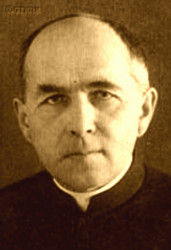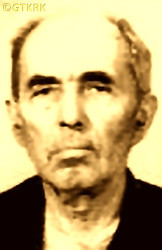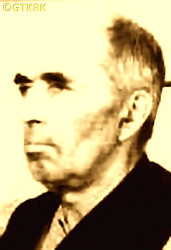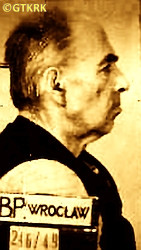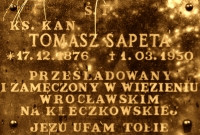Roman Catholic
St Sigismund parish
05-507 Słomczyn
85 Wiślana Str.
Konstancin deanery
Warsaw archdiocese, Poland
full list:
displayClick to display full list

searchClick to search full list by categories
wyświetlKliknij by wyświetlić pełną listę po polsku

szukajKliknij by przeszukać listę wg kategorii po polsku

Martyrology of the clergy — Poland
XX century (1914 – 1989)
personal data
surname
SAPETA
surname
versions/aliases
SAPYTA
forename(s)
Thomas (pl. Tomasz)
function
diocesan priest
creed
Latin (Roman Catholic) Church RCmore on
en.wikipedia.org
[access: 2014.09.21]
diocese / province
Przemyśl diocesemore on
www.przemyska.pl
[access: 2013.02.15]
Katowice diocesemore on
en.wikipedia.org
[access: 2013.05.19]
Wrocław archdiocesemore on
en.wikipedia.org
[access: 2013.05.19]
honorary titles
Expositorii Canonicalis canonmore on
Expositorii Canonicalis canon
(c. 1929)
date and place
of death
19.02.1950

Wrocławtoday: Wrocław city pov., Lower Silesia voiv., Poland
more on
en.wikipedia.org
[access: 2021.04.02]
alt. dates and places
of death
01.03.1950
details of death
After German and Russian invasion of Poland in 09.1939 and start of the World War II arrested on 10.10.1939 by the Russians.
Released without however the right to leave the county.
After German attack of Russia and Russian occupied Polish territories in 06.1941 arrested by collaborating with Germans Ukrainian police.
Released but in 1942 forced to leave his Lipowiec parish for the constant harassment by the Ukrainian nationalists.
In 1946 after German defeat and start of Russian occupation falsely accused by new Commie‐Nazi authorities and released from ministerial duties by the Przemyśl bishop's Curia.
Settled with his sister in Stubno in Przeworsk county.
There on 19.05.1947 arrested by the Commie‐Nazis again falsely accused of collaboration with genocidal Ukrainian nationalist organisation UPA.
On 19.07.1947 released.
Went to Lower Silesia where asked by the Wrocław diocese Apostolic Administrator to get involved in defense of Sisters of Mary the Immaculate facing eviction in Bardo Śląskie and brutally attacked by Commie‐Nazis.
On 18.01.1949 became the curatus of their Congregation in Bardo.
Wrote letters and petitions.
Corresponded with „New York Times”.
Under „Tes” alias wrote to Polish press in the West.
Corresponded with Major Gordon Smith, the administrator of Trieste, the husband of his niece.
On 17.02.1949 arrested by Polish Commie‐Nazi secret services UB, part of Russian NKVD.
On 18.02.1949 escaped.
Went into hiding in Kraków.
Then with Katowice bishop's Curia permission on 05.03.1949 took the Bojszowy parish as its priest.
There on 10.03.1949 arrested again by UB.
Jailed in Katowice and on 19.03.1949 transported to Wrocław prison.
On 17.10.1949 sentenced to two years imprisonment – for „keeping the chronicle of the Lipowiec parish, the list of people destined for extermination [prob. concerns the documents about Russian genocide in Katyn], the draft letter to Osóbka–Morawski [a socialist activist who contributed significantly to the installation of Commie‐Nazism in Poland], the poem «Czerwona Zaraza» (Eng. «Red Calamity») […] that could cause real damage to the interests of the state”.
Held in prison No. 1 in Wrocław.
Soon after perished in prison in unexplained circumstances.
cause of death
extermination
perpetrators
Russians / Poles
sites and events
Katowice (prison)Click to display the description, «Genocidium Atrox»Click to display the description, Ribbentrop‐MolotovClick to display the description, Pius XI's encyclicalsClick to display the description
date and place
of birth
17.12.1876Birth certification on:
photos.szukajwarchiwach.gov.pl
[access: 2025.03.18]

Kąkolówkatoday: Błażowa gm., Rzeszów pov., Subcarpathia voiv., Poland
more on
en.wikipedia.org
[access: 2021.10.09]
parents
SAPYTA Andrew
🞲 ?, ? — 🕆 ?, ?

BOBER Louise
🞲 ?, ? — 🕆 ?, ?
baptism
17.12.1876Birth certification on:
photos.szukajwarchiwach.gov.pl
[access: 2025.03.18]

Błażowatoday: Błażowa gm., Rzeszów pov., Subcarpathia voiv., Poland
more on
en.wikipedia.org
[access: 2021.05.06]
St Martin the Bishop and Confessor RC church
presbyter (holy orders)
ordination
1908

positions held
1949
administrator — Bojszowytoday: Bojszowy gm., Bieruń‐Lędziny pov., Silesia voiv., Poland
more on
en.wikipedia.org
[access: 2021.10.09] ⋄ Nativity of St John the Baptist RC parish
1947 – 1949
resident — Bardotoday: Bardo gm., Ząbkowice Śląskie pov., Lower Silesia voiv., Poland
more on
en.wikipedia.org
[access: 2022.04.12] ⋄ monastery, Ursulines OSU — also: chaplain to the Ursuline Sisters
1945 – 1946
parish priest — Rudnik nad Sanemtoday: Rudnik nad Sanem gm., Nisko pov., Subcarpathia voiv., Poland
more on
en.wikipedia.org
[access: 2021.10.09] ⋄ Holy Trinity RC parish ⋄ Rudnik nad Sanemtoday: Rudnik nad Sanem gm., Nisko pov., Subcarpathia voiv., Poland
more on
en.wikipedia.org
[access: 2021.10.09] RC deanery
1942 – 1945
resident — Żołyniatoday: Żołynia gm., Łańcut pov., Subcarpathia voiv., Poland
more on
en.wikipedia.org
[access: 2021.12.18] ⋄ St John Cantius the Confessor RC parish — support in parish office
1933 – 1942
parish priest — Lipovetstoday: part of Voroblevichi village, Medenychi hrom., Drohobych rai., Lviv obl., Ukraine
more on
uk.wikipedia.org
[access: 2023.03.02] ⋄ St Anne RC parish ⋄ Drohobychtoday: Drohobych urban hrom., Drohobych rai., Lviv obl., Ukraine
more on
en.wikipedia.org
[access: 2021.10.09] RC deanery
1915 – 1933
parish priest — Stubnotoday: Stubno gm., Przemyśl pov., Subcarpathia voiv., Poland
more on
en.wikipedia.org
[access: 2021.10.09] ⋄ Blessed Virgin Mary of Mount Carmel RC parish ⋄ Mostyska / Przemyśl suburbsdeanery names/seats RC deanery
1912 – 1915
curatus/rector/expositus — Lipovetstoday: part of Voroblevichi village, Medenychi hrom., Drohobych rai., Lviv obl., Ukraine
more on
uk.wikipedia.org
[access: 2023.03.02] ⋄ St Anne RC church ⋄ Rykhtychitoday: Drohobych urban hrom., Drohobych rai., Lviv obl., Ukraine
more on
en.wikipedia.org
[access: 2021.10.09], Exaltation of the Holy Cross RC parish ⋄ Drohobychtoday: Drohobych urban hrom., Drohobych rai., Lviv obl., Ukraine
more on
en.wikipedia.org
[access: 2021.10.09] RC deanery
c. 1911 – 1912
administrator — Nowosielcetoday: Przeworsk gm., Przeworsk pov., Subcarpathia voiv., Poland
more on
en.wikipedia.org
[access: 2021.10.09] ⋄ Holy Cross, Assumption of the Blessed Virgin Mary into Heaven, St John the Evangelis, St Mary Magdalene, St Anthony, St Catherine and St Leonard from Abbata RC parish ⋄ Przeworsktoday: Przeworsk urban gm., Przeworsk pov., Subcarpathia voiv., Poland
more on
en.wikipedia.org
[access: 2021.10.09] RC deanery
1908 – c. 1910
vicar — Nowosielcetoday: Przeworsk gm., Przeworsk pov., Subcarpathia voiv., Poland
more on
en.wikipedia.org
[access: 2021.10.09] ⋄ Holy Cross, Assumption of the Blessed Virgin Mary into Heaven, St John the Evangelis, St Mary Magdalene, St Anthony, St Catherine and St Leonard from Abbata RC parish ⋄ Przeworsktoday: Przeworsk urban gm., Przeworsk pov., Subcarpathia voiv., Poland
more on
en.wikipedia.org
[access: 2021.10.09] RC deanery
c. 1904 – 1908
student — Przemyśltoday: Przemyśl city pov., Subcarpathia voiv., Poland
more on
en.wikipedia.org
[access: 2021.04.01] ⋄ philosophy and theology, Theological Seminary
sites and events
descriptions
Katowice (prison): Detention centre run by Germans and later, in 1945, took over by the Commie‐Nazis.
«Genocidium Atrox»: In 1939‐1947, especially in 1943‐1944, independent Ukrainian units, mainly belonging to genocidal Ukrainian organizations OUN (political arm) and UPA (military arm), supported by local Ukrainian population, murdered — often in extremely brutal way — in Volyn and surrounding regions of pre‐war Poland, from 130,000 to 180,000 Poles, all civilians: men, women, children, old and young. Polish‐Ukrainian conflict that openly emerged during and after World War I (in particular resulting in Polish‐Ukrainian war of 1918‐1919), that survived and even deepened later when western Ukraine became a part Poland, exploded again after the outbreak of the World War II in 09.1939. During Russian occupation of 1939‐1941, when hundreds of thousands of Poles were deported into central Russia, when tens of thousands were murdered (during so‐called Katyń massacres, among others), this open conflict had a limited character, helped by the fact that at that time Ukrainians, Ukrainian nationalists in particular, were also persecuted by the Russians. The worst came after German‐Russian war started on 22.06.1941 and German occupation resulted. Initially Ukrainians supported Germans (Ukrainian police was initiated, Ukrainians co—participated in extermination of the Jews and were joining army units fighting alongside Germans). Later when German ambivalent position towards Ukraine became apparent Ukrainians started acting independently. And in 1943 one of the units of aforementioned Ukrainian OUN/UPA organization, in Volyn, started and perpetrated a genocide of Polish population of this region. In mere few weeks OUN/UPA murdered, with Germans passively watching on the sidelines, more than 40,000 Poles. This strategy was consequently approved and adopted by all OUN/UPA organisations and similar genocides took place in Eastern Lesser Poland (part of Ukraine) where more than 20,000 Poles were slaughtered, meeting however with growing resistance from Polish population. Further west, in Chełm, Rzeszów, etc. regions this genocide turned into an extremely bloody conflict. In general genocide, perpetrated by Ukrainian nationalists, partly collaborating with German occupants, on vulnerable Polish population took part in hundreds of villages and small towns, where virtually all Polish inhabitants were wiped out. More than 200 priests, religious and nuns perished in this holocaust — known as «Genocidium Atrox» (Eng. „savage genocide”) The nature and purpose of genocide is perhaps best reflected in the song sung by the murderers: „We will slaughter the Poles, we will cut down the Jews, we must conquer the great Ukraine” (ukr. „Поляків виріжем, Євреїв видусим, велику Україну здобути мусим”). This holocaust and conflict ended up in total elimination of Polish population and Polish culture from Ukraine, in enforced deportations in 1944‐1945 of remaining Poles from Ukraine and some Ukrainians into Ukraine proper, and finally in deportation of Ukrainians from East‐South to the Western parts of Polish republic prl by Commie‐Nazi Russian controlled Polish security forces („Vistula Action”). (more on: www.swzygmunt.knc.plClick to attempt to display webpage
[access: 2021.06.20])
Ribbentrop‐Molotov: Genocidal Russian‐German alliance pact between Russian leader Joseph Stalin and German leader Adolf Hitler signed on 23.08.1939 in Moscow by respective foreign ministers, Mr. Vyacheslav Molotov for Russia and Joachim von Ribbentrop for Germany. The pact sanctioned and was the direct cause of joint Russian and German invasion of Poland and the outbreak of the World War II in 09.1939. In a political sense, the pact was an attempt to restore the status quo ante before 1914, with one exception, namely the „commercial” exchange of the so‐called „Kingdom of Poland”, which in 1914 was part of the Russian Empire, fore Eastern Galicia (today's western Ukraine), in 1914 belonging to the Austro‐Hungarian Empire. Galicia, including Lviv, was to be taken over by the Russians, the „Kingdom of Poland” — under the name of the General Governorate — Germany. The resultant „war was one of the greatest calamities and dramas of humanity in history, for two atheistic and anti‐Christian ideologies — national and international socialism — rejected God and His fifth Decalogue commandment: Thou shall not kill!” (Abp Stanislav Gądecki, 01.09.2019). The decisions taken — backed up by the betrayal of the formal allies of Poland, France and Germany, which on 12.09.1939, at a joint conference in Abbeville, decided not to provide aid to attacked Poland and not to take military action against Germany (a clear breach of treaty obligations with Poland) — were on 28.09.1939 slightly altered and made more precise when a treaty on „German‐Russian boundaries and friendship” was agreed by the same murderous signatories. One of its findings was establishment of spheres of influence in Central and Eastern Europe and in consequence IV partition of Poland. In one of its secret annexes agreed, that: „the Signatories will not tolerate on its respective territories any Polish propaganda that affects the territory of the other Side. On their respective territories they will suppress all such propaganda and inform each other of the measures taken to accomplish it”. The agreements resulted in a series of meeting between two genocidal organization representing both sides — German Gestapo and Russian NKVD when coordination of efforts to exterminate Polish intelligentsia and Polish leading classes (in Germany called «Intelligenzaktion», in Russia took the form of Katyń massacres) where discussed. Resulted in deaths of hundreds of thousands of Polish intelligentsia, including thousands of priests presented here, and tens of millions of ordinary people,. The results of this Russian‐German pact lasted till 1989 and are still in evidence even today. (more on: en.wikipedia.orgClick to attempt to display webpage
[access: 2015.09.30])
Pius XI's encyclicals: Facing the creation of two totalitarian systems in Europe, which seemed to compete with each other, though there were more similarities than contradictions between them, Pope Pius XI issued in 03.1937 (within 5 days) two encyclicals. In the „Mit brennender Sorge” (Eng. „With Burning Concern”) published on 14.03.1938, condemned the national socialism prevailing in Germany. The Pope wrote: „Whoever, following the old Germanic‐pre‐Christian beliefs, puts various impersonal fate in the place of a personal God, denies the wisdom of God and Providence […], whoever exalts earthly values: race or nation, or state, or state system, representatives of state power or other fundamental values of human society, […] and makes them the highest standard of all values, including religious ones, and idolizes them, this one […] is far from true faith in God and from a worldview corresponding to such faith”. On 19.03.1937, published „Divini Redemptoris” (Eng. „Divine Redeemer”), in which criticized Russian communism, dialectical materialism and the class struggle theory. The Pope wrote: „Communism deprives man of freedom, and therefore the spiritual basis of all life norms. It deprives the human person of all his dignity and any moral support with which he could resist the onslaught of blind passions […] This is the new gospel that Bolshevik and godless communism preaches as a message of salvation and redemption of humanity”… Pius XI demanded that the established human law be subjected to the natural law of God , recommended the implementation of the ideal of a Christian state and society, and called on Catholics to resist. Two years later, National Socialist Germany and Communist Russia came together and started World War II. (more on: www.vatican.vaClick to attempt to display webpage
[access: 2023.05.28], www.vatican.vaClick to attempt to display webpage
[access: 2023.05.28])
sources
personal:
www.encyklo.plClick to attempt to display webpage
[access: 2021.12.19], www.marianki.katowice.opoka.org.plClick to attempt to display webpage
[access: 2013.01.26], ipn.gov.plClick to attempt to display webpage
[access: 2016.05.30], photos.szukajwarchiwach.gov.plClick to attempt to display webpage
[access: 2025.03.18], silesia.edu.plClick to attempt to display webpage
[access: 2020.04.25]
bibliographical:
„Lexicon of the clergy vicimised in prl in 1945‐1989”, collective work edited by Jerzy Myszor, Warsaw, 2002
original images:
ipn.gov.plClick to attempt to display webpage
[access: 2013.06.23], ipn.gov.plClick to attempt to display webpage
[access: 2022.04.12], ipn.gov.plClick to attempt to display webpage
[access: 2022.04.12], armiakrajowazgorzelec.blogspot.comClick to attempt to display webpage
[access: 2014.11.22], armiakrajowazgorzelec.blogspot.comClick to attempt to display webpage
[access: 2014.11.22]
LETTER to CUSTODIAN/ADMINISTRATOR
If you have an Email client on your communicator/computer — such as Mozilla Thunderbird, Windows Mail or Microsoft Outlook, described at WikipediaPatrz:
en.wikipedia.org, among others — try the link below, please:
LETTER to CUSTODIAN/ADMINISTRATORClick and try to call your own Email client
If however you do not run such a client or the above link is not active please send an email to the Custodian/Administrator using your account — in your customary email/correspondence engine — at the following address:

giving the following as the subject:
MARTYROLOGY: SAPETA Thomas
To return to the biography press below:
 Click to return to biography
Click to return to biography








